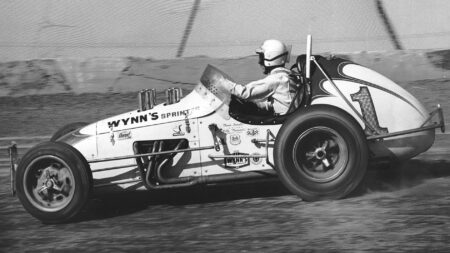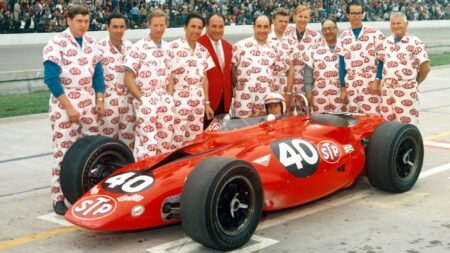Branson and McCluskey were hardly the only Yank soldiers forced to lead difficult lives. Following a desperate struggle, Big Jud Larson, demon of the dirt tracks, was made to climb inside a Watson ‘funny car’ and ordered to get it up to speed. He did, but his lower body suffered cramp and when Larson’s legs fell asleep, his little roller skate went into a wild spin, then slid for 230 metres before finally catching the inside wall. Bouncing clear, it bellyslid a further 90 metres to wallop the outside one.
Larson survived; Davey MacDonald and Eddie Sachs didn’t. Strapped inside a gasoline-laden Mickey Thompson nightmare with oversize side-saddle fuel bays, stone-cold Davey, on the second lap of ’64’s Indy 500, managed to find the cement and blow himself and Sachs sky-high in an enormous orange fireball that shook the ground, disabled another five automobiles, red-flagged the race and kept fire crews busy for over 100 minutes.
A further reckoning occurred in 1966. Three-quarters of the starting field in the Silver Anniversary 500 were ‘funny car’ clones. Down came the green. A two-speed Gerhardt was jumped by a two-speed Watson, and when a Vollstedt with a Lotus-type Hewland came upshifting through the gears between them, the Vollstedt’s right-rear wheel caught the Gerhardt’s left-front. In the melee that followed, a third of the field was wiped out.

Dave MacDonald in wide-bodied Thompson Ford ahead of the fateful 1964 race
LAT
Drivers continued exchanging blood-chilling anecdotes, but the rear-engine revolution sped on anyway. Nobody wanted to go back to racing roadster ironclads no matter what happened. Accordingly, quackery and quack cars became the Indy menu of the ’60s and ’70s: everybody wanted to look as smart as Colin Chapman. There were stock-blocks and turbines; rear-wheel-drives, front-wheel-drives, four-wheel-drives; rear-engines and mid-engines and double-engines and (no joke) a bizarre side-engine — Smokey Yunick’s you-had-to-see-it-to-believe-it capsule car. What was occurring, in other words, was the exact opposite of that comedy flick in which Jack Nicholson says, “Go sell crazy some place else. We’re all stocked up here.” For all its hilarious ‘funny car’ revolt, crazy was just what the Brickyard did want.
Then Cale Yarborough, up from NASCAR to embark on open-wheel racing, made what he thought was his amazing discovery. Having experienced scare after scare from counterfeit Lotuses, bogus Brabhams and hybrid Lolas, Yarborough anxiously scoped out The Brickyard horizon and learned that, contrary to prevailing thought, all of the original hirsute mechanics and brainy fabricators of Team Lotus hadn’t returned to Mother England with Chapman, after all. Finding Indy more congenial than their master had, a few had acquired visas and stayed on. To Yarborough, who fantasised that anybody with an English accent must be a ‘funny car’ genius, the next step was obvious. Rushing to his sponsor, Gene White Racing, he expostulated, “We gotta hire us some of them long-haired Limies!”

Few wanted to steal the secrets of the dihedral Parnelli VPJ-1 Offenhauser
William Murenbeeld/LAT
A few of their Chapmanesque nicknames were Slugger, Rabbit, Chalkie and Angel. But it was Maurice Phillippe who initially climbed the highest and fell the furthest. Perhaps unique among Team Lotus alumni, he had neither long hair nor screwball substitute name. And in 1972, for its trio of champions Mario Andretti, Al Unser, and Joe Leonard the Vel’s Parnelli Jones team (US racing’s richest) ordered him to engineer something brilliant Phillippe obeyed. Amidst Pentagon-like secrecy, he disgorged a huge folly known as the dihedral car — a freak dreadnought with stubby wings sprouting from its fat bulk in a V. It became a great white elephant, causing VFI’s champions nightmares and its sponsors an enormous financial bath.
Meanwhile, Rabbit, Slugger and Chalkie heeded Cale Yarborough’s abject cries for help and were canonised into the new medicine men and wizards of ‘funny car’ design. The automobile they created, known as the Atlantas, was possibly superior to Phillippe’s notorious dihedral. Fate, however, seemed against it. Yarborough’s team relied on the turbocharged Ford, and a lot of time got wasted switching over to the faster turbo Offenhauser. Yarborough had by then renounced Indianapolis and returned to the greener, safer pastures of NASCAR. Practically the only driver left available was Jimmy Caruthers, and he was on crutches. So Rabbit, Slugger and Chalkie took his crutches away from him and put him in the cockpit at Michigan International Speedway. He qualified an impressive fourth fastest, but this was the Atlantas’ only big moment.





